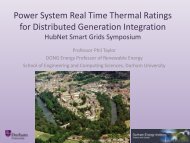Study of a DC/DC Converter in Alternate Discontinuous Mode
Study of a DC/DC Converter in Alternate Discontinuous Mode
Study of a DC/DC Converter in Alternate Discontinuous Mode
You also want an ePaper? Increase the reach of your titles
YUMPU automatically turns print PDFs into web optimized ePapers that Google loves.
IV.SIMULATIONS AND LOSS CALCULATIONSThree test scenarios were chosen and details are given <strong>in</strong>Table 1. For each scenario a fast thyristor and a phase controlthyristor was used to enable a comparison between theswitch<strong>in</strong>g frequency and the power transfer <strong>of</strong> the converter.The voltage ratios chosen correspond to cases seen <strong>in</strong> [9],[14]. The converter model for each scenario was arranged as<strong>in</strong> Fig. 2 and was implemented us<strong>in</strong>g MATLAB Simul<strong>in</strong>k.These specific thyristors were chosen as the fast thyristorcan be operated <strong>in</strong> the kilohertz range, reduc<strong>in</strong>g the size <strong>of</strong> theresonant components, and the phase control thyristor with itssignificantly higher voltage and current rat<strong>in</strong>gs can enablehigher power transfer with fewer devices. For the losscalculation only the conduction loss <strong>of</strong> the thyristors wasconsidered, as the device is s<strong>of</strong>t-switched the switch<strong>in</strong>g losses<strong>of</strong> the converter were assumed to be negligible.Table 1: Test scenarios and converter dataThyristor 5STF 11F3010 5STP 42U6500Optimum frequency 5 kHz 500 HzMaximum voltage 6.5 kV 3 kVRated voltage 3.5 kV 1.5 kVPower 5 MW 20 MWCase A±2.5 kV±150 kVCase B±25 kV±150 kVCase A±150 kV±250 kVL 1 2.7 mH 6.9 mHL 2 0.65 mH 1.6 mHC 0.14 µF 6.7 µFN 204 88Power 50 MW 240 MWL 1 1.71 mH 9.3 mHL 2 0.19 mH 0.26 mHC 0.33 µF 8.0 µFN 134 100Power 300 MW 1.2 GWL 1 4.0 mH 9.9 mHL 2 1.4 mH 3.6 mHC 0.1 µF 4.0 µFN 534 229This scenario is for when a <strong>DC</strong> collection system, at amedium voltage, is connected to a HV<strong>DC</strong> grid. An example <strong>of</strong>this would be if an <strong>of</strong>fshore w<strong>in</strong>d farm made use <strong>of</strong> a mediumvoltage<strong>DC</strong> collection network, necessitat<strong>in</strong>g a step-up<strong>DC</strong>/<strong>DC</strong> conversion to the HV<strong>DC</strong> network.C. Interfac<strong>in</strong>g <strong>of</strong> Two HV<strong>DC</strong> SystemsAs cable technology improves and voltages <strong>in</strong>crease by tens<strong>of</strong> kilovolts, new HV<strong>DC</strong> systems will built us<strong>in</strong>g the latesttechnology, imply<strong>in</strong>g adjacent projects may not be operated atsimilar voltage levels. These projects can be <strong>in</strong>terconnectedthrough <strong>DC</strong>/<strong>DC</strong> conversion.Figure 5: Relationship between frequency and powerA. Low-Voltage <strong>DC</strong> Distribution to HV<strong>DC</strong> GridThis scenario is, for example, when a s<strong>in</strong>gle <strong>DC</strong>/<strong>DC</strong>converter is used to connect multiple low-voltage <strong>DC</strong> devicesto a HV<strong>DC</strong> network. For example, the connection <strong>of</strong> severalphotovoltaic arrays, which produce a low voltage <strong>DC</strong> output,to a HV<strong>DC</strong> grid would necessitate the use <strong>of</strong> high step <strong>DC</strong>/<strong>DC</strong>converter. In this case, the values <strong>of</strong> the <strong>in</strong>ductors have beenmodified compared to the optimal results from (12) and (13)because the high stepp<strong>in</strong>g ratio resulted <strong>in</strong> very small valuesfor L 2 , lead<strong>in</strong>g to a second resonant period too short comparedto the ext<strong>in</strong>ction time <strong>of</strong> the thyristors.B. Medium-Voltage Distribution to HV<strong>DC</strong> GridFigure 6: Waveforms <strong>of</strong> low voltage ratio converter operat<strong>in</strong>g at 400 HzD. Results and DiscussionFig. 5 shows the data from the simulations at differentfrequency and the prediction from (7) and (11). The closematch between the data po<strong>in</strong>ts and the model proves the l<strong>in</strong>earrelationship between switch<strong>in</strong>g frequency and the powertransfer, and the conduction loss. The converter has also beenoperated past the set maximum frequency, i.e. 500 Hz, andshows that extra power transfer can be obta<strong>in</strong>ed if necessary.Fig. 6 shows the voltage across the capacitor and the currentsthrough the <strong>in</strong>ductor when operat<strong>in</strong>g at 400 Hz with a powertransfer <strong>of</strong> approximately 1 GW.
Table 2 shows the relationship between the switch<strong>in</strong>gfrequency and power transfer and conduction power loss forthe three scenarios for both thyristors. The conduction ratio isthe ratio <strong>of</strong> the conduction loss to the power transfer for theconverter and, accord<strong>in</strong>g to the model (7) and (11), is equal<strong>in</strong>dependent from the frequency, as long as the converter isoperated <strong>in</strong> ADM.Table 2: Simulation resultsThyristor 5STF 11F3010 5STP 42U6500P 1 kW/Hz 40 kW/HzCase A Pc 218 W/Hz 3.45 kW/HzPc/P 21.8% 8.6%P 10 kW/Hz 480 kW/HzCase B Pc 184.22 W/Hz 5.29 kW/HzPc/P 1.8% 1.1%P 600 kW/Hz 2.4M W/HzCase C Pc 911 W/Hz 14.77 kW/HzPc/P 1.5% 0.6%From these results, it can be seen that the l<strong>in</strong>ear relationshipis confirmed between the switch<strong>in</strong>g frequency and the powertransfer and conduction loss <strong>of</strong> the device. It was alsoobserved from simulations that conduction losses decrease asthe voltage conversion ratio is reduced. This makes theconverter suitable for use <strong>in</strong> <strong>in</strong>terfac<strong>in</strong>g two HV<strong>DC</strong> systems,when operated <strong>in</strong> ADM. However, for medium to high voltageconversion ratios the exhibits significant conduction lossesdeem<strong>in</strong>g it unsuitable for use <strong>in</strong> <strong>in</strong>terfac<strong>in</strong>g low-voltage <strong>DC</strong>systems with a HV<strong>DC</strong> grid. The results also <strong>in</strong>dicate that thephase control thyristor has superior loss figures and fewerdevices per arm given the devices higher rat<strong>in</strong>gs, at theexpense <strong>of</strong> larger and possibly more costly passivecomponents.V. CONCLUSIONHav<strong>in</strong>g outl<strong>in</strong>ed the importance <strong>of</strong> <strong>DC</strong> to <strong>DC</strong> conversion <strong>in</strong>future HV<strong>DC</strong> networks, a resonant converter topology wasstudied. An alternative operat<strong>in</strong>g pr<strong>in</strong>ciple for this topologywas presented, <strong>in</strong>volv<strong>in</strong>g an alternate operation <strong>of</strong> the twohalves <strong>of</strong> the topology. A full set <strong>of</strong> equations describ<strong>in</strong>g thework<strong>in</strong>g <strong>of</strong> the converter runn<strong>in</strong>g <strong>in</strong> this mode were drawn andestimation <strong>of</strong> the conduction losses performed. The converterwas modeled <strong>in</strong> different HV<strong>DC</strong> grid scenarios to show itspotential diversity <strong>of</strong> applications. It was seen that theconverter exhibits low losses at low conversion ratios and issuited best to <strong>in</strong>terfac<strong>in</strong>g HV<strong>DC</strong> systems up to mediumconversion ratio. A comparison between two different types <strong>of</strong>semiconductors, i.e. high rat<strong>in</strong>gs or fast switch<strong>in</strong>g thyristors,has also been conduct<strong>in</strong>g. On one hand, the higher rat<strong>in</strong>gsthyristors exhibit the lowest conduction losses over all thescenarios. On the other hand, the fast switch<strong>in</strong>g thyristorspermit the converter to be operated at a much higherfrequency, potentially hav<strong>in</strong>g benefits <strong>in</strong> terms <strong>of</strong> passivecomponents volume and cost.REFERENCES[1] D. Van Hertem, M. Ghandhari, and M. Delimar, “Technicallimitations towards a SuperGrid — A European prospective,” <strong>in</strong>2010 IEEE International Energy Conference, 2010, pp. 302–309.[2] D. Van Hertem, M. Ghandhari, J. Curis, O. Despouys, and A.Marz<strong>in</strong>, “Protection requirements for a multi-term<strong>in</strong>al meshed <strong>DC</strong>grid,” Cigre Conference Bologna 2011, pp. 1–4.[3] C. M. Franck, “HV<strong>DC</strong> Circuit Breakers: A Review Identify<strong>in</strong>gFuture Research Needs,” IEEE Transactions on Power Delivery,vol. 26, no. 2, pp. 998–1007, Apr. 2011.[4] J. Häfner and B. Jacobson, “Proactive Hybrid HV<strong>DC</strong> Breakers - Akey <strong>in</strong>novation for reliable HV<strong>DC</strong> grids,” The electric power system<strong>of</strong> the future - Integrat<strong>in</strong>g supergrids and microgrids Internationalsymposium - Cigré, 2011.[5] M. M. C. Merl<strong>in</strong>, T. C. Green, P. D. Mitcheson, D. R. Tra<strong>in</strong>er, D. R.Critchley, and R. W. Crookes, “A new hybrid multi-level voltagesourceconverter with <strong>DC</strong> fault block<strong>in</strong>g capability,” <strong>in</strong> 9th IETInternational Conference on AC and <strong>DC</strong> Power Transmission(AC<strong>DC</strong> 2010), 2010, pp. 1–5.[6] C. D. Barker, C. C. Davidson, D. R. Tra<strong>in</strong>er, and R. S. Whitehouse,“Requirements <strong>of</strong> <strong>DC</strong>-<strong>DC</strong> <strong>Converter</strong>s to facilitate large <strong>DC</strong> Grids,”<strong>in</strong> Cigre Session 2012, 2012.[7] D. Jovcic, “Step-up <strong>DC</strong>–<strong>DC</strong> converter for megawatt sizeapplications,” IET Power Electronics, vol. 2, no. 6, p. 675, 2009.[8] J. Arrillaga, High Voltage Direct Current Transmission, 2nd ed.The Institution <strong>of</strong> Electrical Eng<strong>in</strong>eers, 1998.[9] T. Lüth, M. M. C. Merl<strong>in</strong>, T. C. Green, C. D. Barker, F. Hassan, R.W. Critchley, R. W. Crookes, and K. Dyke, “Performance <strong>of</strong> a <strong>DC</strong> /AC / <strong>DC</strong> VSC System to Interconnect HV<strong>DC</strong> Systems,” <strong>in</strong> 10th IETInternational Conference on AC and <strong>DC</strong> Power Transmission(AC<strong>DC</strong> 2012), 2012, no. Figure 2.[10] N. Mohan, T. M. Undeland, and W. P. Robb<strong>in</strong>s, Power Electronics:converters, applications, and design, 3rd ed. 2003.[11] A. Hagar, “A New Family <strong>of</strong> Transformerless Modular <strong>DC</strong>-<strong>DC</strong><strong>Converter</strong>s for High Power Applications,” University <strong>of</strong> Toronto,2011.[12] D. Jovcic, “Bidirectional, high-power <strong>DC</strong> transformer,” PowerDelivery, IEEE Transactions on, vol. 24, no. 4, pp. 2276–2283,2009.[13] D. Jovcic and B. T. Ooi, “Theoretical aspects <strong>of</strong> fault isolation onhigh-power direct current l<strong>in</strong>es us<strong>in</strong>g resonant direct current/directcurrent converters,” IET Generation, Transmission & Distribution,vol. 5, no. 2, p. 153, 2011.[14] P. Monjean, J. Delanoe, D. Mar<strong>in</strong>, J. Auguste, C. Saudemont, andB. Robyns, “Control strategies <strong>of</strong> <strong>DC</strong>-based <strong>of</strong>fshore w<strong>in</strong>d farm,” <strong>in</strong>14th European Conference on Power Electronics and Applications(EPE 2011), 2011, pp. 1–9.






